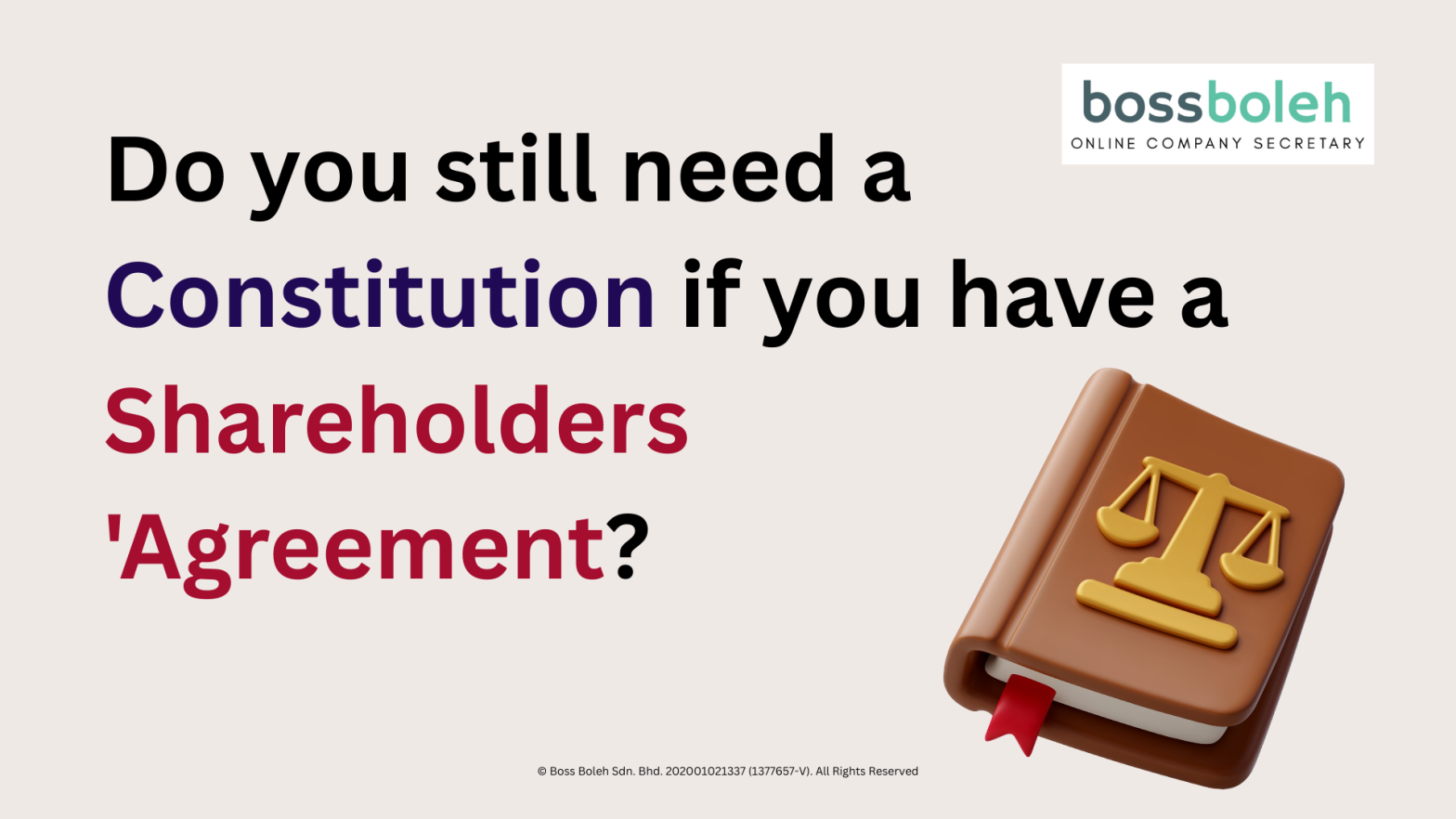
- Shareholders’ Agreement (SHA): A private contract between shareholders that outlines their rights, responsibilities, and how the company is managed. It is enforceable only among the parties who signed it.
- Company Constitution: A legal document that sets out the governing rules of the company. It binds the company, directors, and shareholders and is publicly accessible under the Companies Act 2016 (Malaysia).
Key Differences & Why You Might Still Need a Constitution
| Aspect | Shareholders’ Agreement | Constitution |
| Legal Binding | Only between shareholders who signed | Legally binds company, directors, and all shareholders |
| Public vs. Private | Private, not required to be lodged with SSM | Public, accessible under SSM |
| Flexibility | Can be changed by agreement of signing parties | Requires special resolution (75% shareholder approval) |
| Control over Directors | Can include additional restrictions on director decisions | Define director roles, powers, and decision-making rules |
| Exit Strategy & Dispute Resolution | Can outline share transfer restrictions and dispute resolution | Limited coverage in the absence of an SHA |
Conclusion:
✅ You don’t necessarily need a Constitution if your SHA already covers everything you need.
✅ But having both can provide stronger governance and protection, as the Constitution applies to all shareholders (current and future).
If your company was incorporated without a Constitution, then it follows the default rules under the Companies Act 2016. If you need more customized governance, adopting a Constitution might be beneficial.
“What are the Benefits of Having a Constitution for Preference Shareholders”
If your company has preference shareholders, having a Company Constitution can provide stronger protection and clarify compared to relying solely on a Shareholders’ Agreement (SHA) or the default rules under the Companies Act 2016 (Malaysia). Here’s why a Constitution is beneficial for Preference Shareholders:
1. Legally Binding on All Shareholders (Including Future Ones)
- Unlike a Shareholders’ Agreement, which only binds those who signed it, a Constitution applies to all current and future shareholders.
- This ensures that the rights of preference shareholders remain protected even if new investors or shareholders join.
2. Clear Definition of Preference Share Rights
- Dividends– You can define fixed dividends or cumulative dividends for preference shareholders.
- Voting Rights– Normally, preference shares don’t carry voting rights, but you can specify when they can vote (e.g., on liquidation or major decisions).
- Priority in Liquidation– You can outline that preference shareholders get paid first before ordinary shareholders if the company is liquidated.
🛑 Without a Constitution, preference shares might be subject to uncertain treatment under the Companies Act 2016.
3. Share Transfer & Exit Strategy
- The Constitution can restrict the transfer of preference shares to protect existing investors.
- It can also include redemption rights, allowing preference shareholders to sell back their shares under specific conditions.
- Example: If a preference shareholder wants to exit, the company might be required to buy back their shares at an agreed price.
📌Without a Constitution, the rules on transferring or redeeming preference shares may not be as clear.
4. Protection Against Dilution
- The Constitution can prevent ordinary shareholders from issuing new shares that could reduce the value of preference shares.
- You can include pre-emptive rights, allowing preference shareholders to buy new shares before outsiders.
🔍 Why does this matter?
- If new shares are issued without protections, preference shareholders could lose control or see their dividend entitlements reduced.
5. Priority on Dividends & Payments
- Without a Constitution, dividends are usually declared at discretion of the Board.
- The Constitution can guarantee that preference shareholders receive dividends first before ordinary shareholders receive anything.
💰 Example:
- Ordinary shareholders only get dividends if the company makes a profit.
- Preference shareholders can get fixed annual dividends, regardless of the company profitability.
6. Clarify in Decision-Making & Voting Rights
- The Constitution can specify when preference shareholders have voting rights (e.g., in cases of liquidation, mergers, or significant business decisions).
- If you only have a Shareholders’ Agreement, new shareholders might not be bound by the same rules.
📌 Without a Constitution, preference shareholders may have limited say in key decisions.
7. Flexibility in Customizing Share Classes
- Redeemable Preference Shares (RPS)- Allow company buyback.
- Convertible Preference Shares (CPS)- Can be converted into ordinary shares in the future.
- Participating Preference Shares– Shareholders can receive extra dividends beyond the fixed rate.
🛑 Without a Constitution, these rights may not be fully enforceable.
Conclusion: Do You Need a Constitution for Preference Shareholders?
✅ YES, if you want to:
✔ Ensure preference shareholders’ rights are recognized under company law.
✔ Define clear dividend rights and priority in liquidation.
✔ Restrict share transfers and prevent dilution.
✔ Provide certainly for new and existing shareholders.
✔ Strengthen investor confidence.
❌ Maybe NOT, if:
- Your Shareholders’ Agreement already covers all these points in detail.
- You have no preference shareholders (only ordinary shares).
If you’re raising capital or already have preference shareholders, having both a Constitution and a Shareholders’ Agreement is the best combination for strong governance.
“Can Preference Shareholder Rights in an SHA Contradict the Companies Act 2016?”
Yes, there can be potential issues if you highlight preference shareholder rights only in the Shareholders’ Agreement (SHA) without aligning them with the Companies Act 2016 (CA 2016) or Company Constitution.
Here’s what you need to be aware of:
1. SHA Not Legally Binding on the Company
- The Companies Act 2016 (CA 2016) governs all companies in Malaysia.
- A Shareholders’ Agreement (SHA) is a private contract that binds only the signing parties (existing shareholders), but not the company itself.
- If your SHA contains terms that contradict CA 2016 or are not reflected in the Company Constitution, those terms may not be enforceable.
💡 Solution:
- Include key preference shareholder rights in the Company Constitution to ensure enforceability.
- Keep the SHA as an additional layer of the agreement between shareholders.
2. Risk of Conflict Between SHA & Constitution
- If the SHA states one set of the rights for preference shareholders but the Company Constitution (or CA 2016) says something different, the Constitution prevails.
- Example:
◽ SHA states that preference shareholders must receive dividends yearly, even if the company makes a loss.
◽ CA 2016 states that dividends can only be declared if the company has profits.
◽ Issue: If the company lacks profit, the SHA clause is invalid as it contradicts the law.
💡 Solution:
- Ensure both the SHA and Constitution are aligned with CA 2016 to avoid disputes.
- Avoid including terms in the SHA that go against public policy or statutory laws.
3. Share Transfer Restrictions Might Be Unenforceable
- Many SHAs restrict the transfer of preferences shares (e.g., requiring shareholder approval before selling shares).
- However, CA 2016 allows shareholders to transfer shares freely unless the Constitution restricts it.
- If your SHA restricts transfers, but your Constitution is silent, then the SHA clause may not be legally enforceable.
💡 Solution:
- Include share transfer restrictions in the Company Constitution to make them legally binding.
4. Voting Rights Issues
- CA 2016 requires that all shareholders get at least one vote for certain major decisions (e.g., winding up the company).
- If your SHA completely removes voting rights from preference shareholders, it may be unenforceable.
- SHA provisions that contradict CA 2016 may be ignored by the courts.
💡 Solution:
- Instead of removing voting rights completely, limit them to specific decisions (e.g., preference shareholders vote only on liquidation or major transactions).
CA 2016 Overrules the SHA in Certain Situations
There are several provisions in CA 2016 that override any private agreement, including an SHA. Some key examples:
| Issue | SHA Clause | Potential Problem |
| Dividends | Guarantee dividends to preference shareholders, even in a loss-making year | CA 2016 only allows dividend if the company has profits. Any agreement contradicting this is void. |
| Voting Rights | Completely removes voting rights of preference shareholders | CA 2016 gives certain rights to all shareholders (e.g., winding up resolutions). |
| Share Transfers | Requires board approval before transferring shares | CA 2016 allows free transfer unless the Constitution says otherwise. |
| Redemption of Shares | Requires the company to buy back preference shares anytime | CA 2016 imposes conditions on share buybacks, including solvency tests. |
How to Avoid These Issues?
✅ Step 1: Put Key Rights in the Constitution
- Since CA 2016 recognizes the Company Constitution as legally binding, include preference shareholder rights inside.
✅ Step 2: Ensure SHA & Constitution Align
- The SHA can have additional details, but it should not contradict CA 2016 for the Constitution.
✅ Step 3: Follow CA 2016 in Key Areas
- Any dividend rights, voting restrictions, share transfers, or liquidation preferences must comply with statutory requirements.
✅ Step 4: Review & Update Regularly
- Laws can change, so periodically review both the SHA and Constitution to keep them compliant.
Conclusion: Can You Highlight Preference Shareholder Rights in the SHA?
- Yes, but it should be consistent with CA 2016 and the Company Constitution.
- If a conflict arises, CA 2016 and the Constitution will prevail over the SHA.
- To fully protect preference shareholders, the best practice is to include their rights in both the SHA and Constitution.
Here’s a simple table to explain the relationship between CA 2016 vs. Company Constitution and why having a Constitution can still be beneficial for you
“Does the Companies Act 2016 (CA 2016) or the Constitution Come First?”
| Aspect | Companies Act 2016 (CA 2016) | Company Constitution |
| Which comes first? | CA 2016 always takes priority | Must comply with CA 2016 but allow customization |
| Legally Required? | No, Constitution is optional | Not mandatory, but useful for clarify and governance |
| Who does it apply to? | All companies in Malaysia | Only applies to the specific company that adopts it |
| Enforceability | Automatically applies by law | Binding on the company, directors, and shareholders |
| Can override CA 2016? | ❌ No | ❌ No, but can provide more detailed rules |
| Why have it? | Sets out default company rules | Helps customize company governance and structure |
| Best for? | Small businesses that follow default CA 2016 rules | Companies needing clear governance, investor protection and custom rights |
“Why Have a Company Constitution If CA 2016 Exists?”
| Key Area | CA 2016 (Default Rules) | With a Company Constitution |
| Director Powers & Roles | Basic rules on director duties and decisions | Can customize director powers, decision-making rules, and restrictions |
| Shareholder Rights | All shareholders have basic voting and dividend rights | Can define different rights for preference shareholders, dividend priority, etc. |
| Voting Rights | Standard 1 share = 1 vote | Can set different voting rights (e.g., preference shareholders with limited voting) |
| Dividends | Can only be paid if there are profits | Can specify how and when preference shareholders receive dividends |
| Share Transfers | Shares can be freely transferred unless restricted | Can limit share transfers to prevent external investors from taking control |
| Dispute Resolution | CA 2016 has no standard dispute resolution | Can include mediation/ arbitration rules for resolving shareholder disputes |
| Company Exit & Liquidation | Follows CA 2016’s winding-up process | Can prioritize preference shareholders for payout in liquidation |
📌Summary
✅ CA 2016 applies to all companies, but it has basic default rules.
✅ A Company Constitution is optional but useful for companies wanting clear governance and investor protections.
✅ Having a Constitution helps prevent shareholder conflicts and ensures company rules are clear for all.
📌When Should a Company Have a Constitution?
A Company Constitution is recommended if:
✅ The company has multiple shareholders and needs clear rules on shareholding rights.
✅ The company wants to customize director powers, decision-making and share transfers.
✅ The company has preference shareholders and need to protect their rights (dividends, voting, and exit).
✅ The company needs a clear framework for resolving disputes and avoiding legal uncertainty.
If you are unsure, default CA 2016 rules may be enough for simple companies. But for growth-stage businesses, startups with investors, or companies raising funds, a Company Constitution provides extra protection.
Join our online webinar to learn everything about company registration, compliance and getting your business off the ground! Don’t miss out!


For more details, feel free to WhatsApp us!
📲 WhatsApp: 018-7678055
